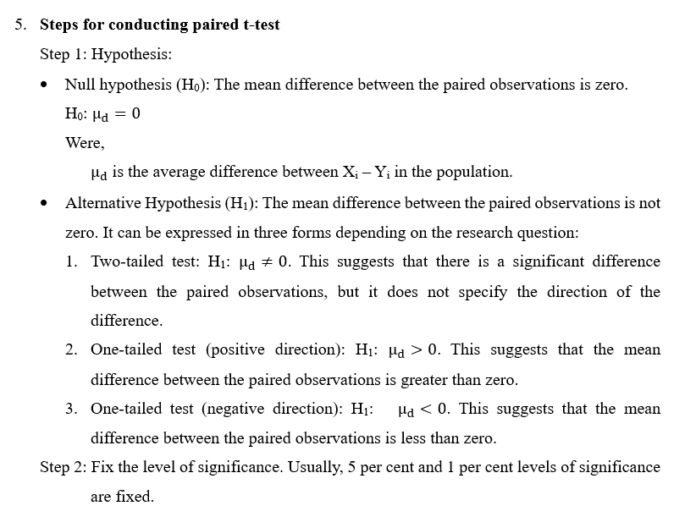1.
Introduction
A paired t-test compares the means of two related
groups to determine if there is a statistically significant difference between
them. This test is used when the same subjects are measured twice, such as
before and after a treatment. By analyzing the differences between paired
observations, the paired t-test accounts for variability within subjects,
making it a powerful tool for detecting changes or effects in experiments and
repeated-measures studies.
2. When to use paired t test
A paired t-test is used to compare the means of
two related groups to determine if there is a statistically significant
difference. This test is applicable when the same subjects are measured twice or when pairs of related subjects are
matched. Use a paired t-test in the following scenarios:
1.
The same subjects are
measured twice, such as before and after treatment.
2.
Pairs of related subjects
are matched based on specific criteria.
3. The objective is to
detect significant changes within subjects by analyzing differences between
paired observations.
3. Assumptions
of paired t-test
1. Paired Observations:
The data consists of pairs of related observations (e.g., measurements
before and after treatment on the same subjects).
2. Continuous Data:
The differences between paired observations are continuous and measured on an
interval or ratio scale.
3. Normality:
The differences between the paired observations are approximately normally
distributed.
4.
Independence:
The pairs are independent of each other.
5. Scale of Measurement:
The data should be measured at least at the interval level, allowing for the
calculation of meaningful differences.
4. How
is paired t-test is different from two sample independent t-test
The
paired t-test compares the means of two related groups, focusing on differences
within the same subjects, assuming paired observations. In contrast, the
two-sample independent t-test compares the means of two independent groups,
assuming observations are independent and unrelated. The paired t-test controls
for within-subject variability, while the independent t-test assesses
differences between separate groups, each with its own distinct subjects.
6. Solved
example
The data of the
following table indicates the milk production of 12 cows for evening and
morning milking. Test that the milk production of both the time is same.
|
Milk yield in |
|||||
|
Cows |
Morning |
Evening |
Cows |
Morning |
Evening |
|
1 |
4.5 |
4.0 |
7 |
5.0 |
4.5 |
|
2 |
5.6 |
4.5 |
8 |
7.5 |
7.5 |
|
3 |
7.5 |
7.5 |
9 |
10.5 |
10.0 |
|
4 |
8.0 |
7.6 |
10 |
7.0 |
7.0 |
|
5 |
8.0 |
5.5 |
11 |
10.0 |
9.5 |
|
6 |
8.5 |
8.5 |
12 |
8.5 |
8.5 |
Same problem analysis in Agri Analyze:
The best part of performing analysis
with Agri Analyze is that auto interpretation along with assumption testing.
Step 1: Open link https://agrianalyze.com/OneSampleTTest.aspx
(For first time users free registration is mandatory)
Step 2: Prepare data in csv file as shown below:
Step3: Upload data, add level of significance and average difference, add
variable name and category type
Add level of Significance: we have kept 0.05 i.e. 5%;
Add variable name : Milk production in Liter
Category Type: As we are comparing milk production in Morning and Evening we have wrote “Time of Milking”
Step4: Click on the submit and pay nominal fee and get the output along with interpretation in report.
Output:
Fundamentals of mathematical statistics. Sultan Chand & Sons.
The blog is written by:










